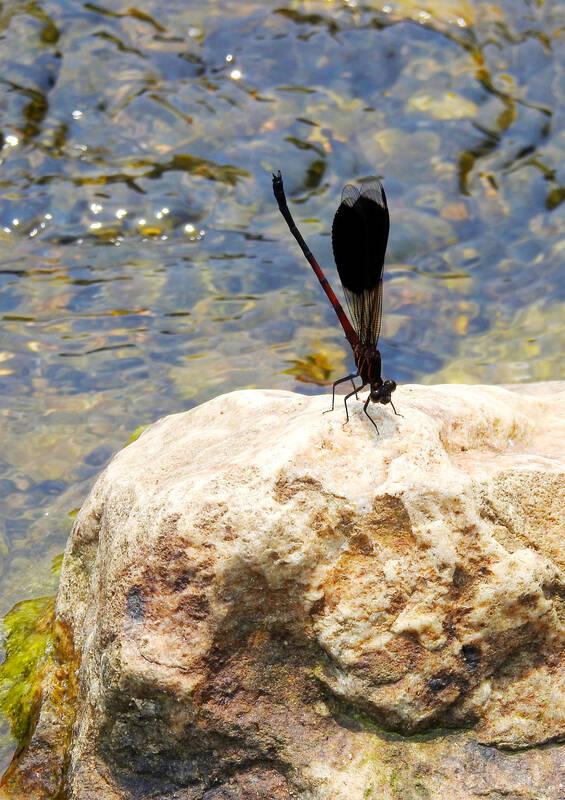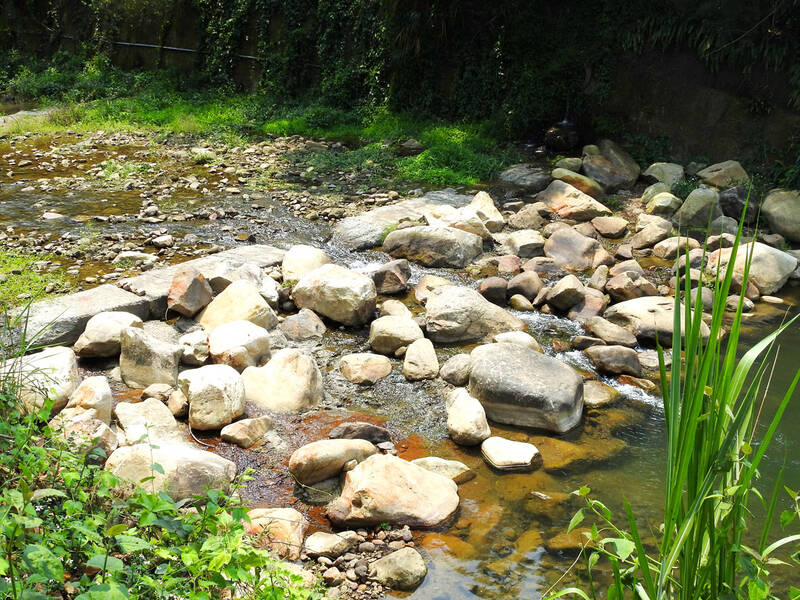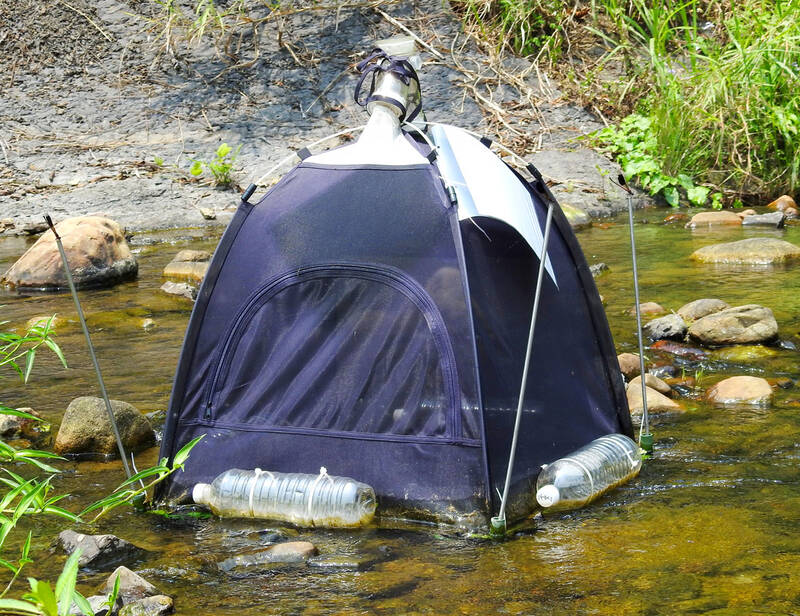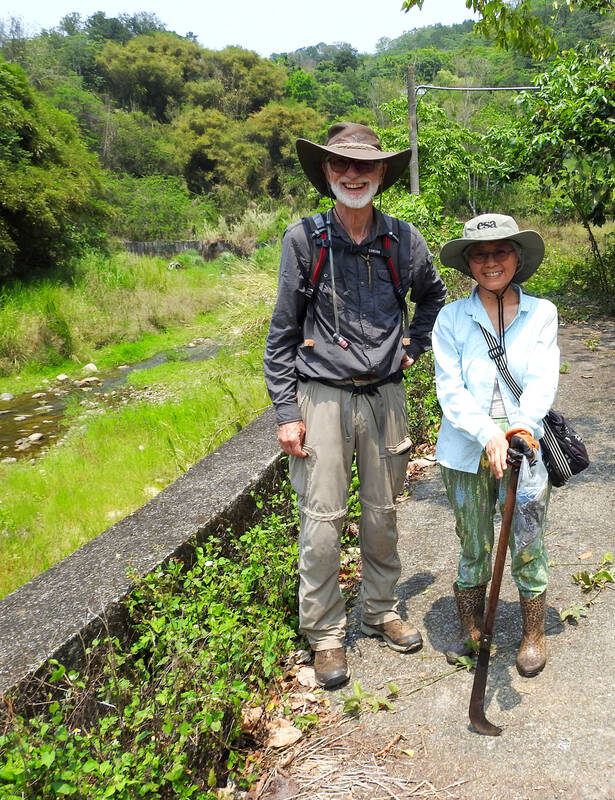On Christmas Eve 2022, Peter Chesson and his wife, Sheue Chiou-rong (許秋容), received some alarming news.
The couple learned that the owner of a plot of land adjacent to the one on which they live in Nantou County’s Guosing Township (國姓) had decided to sell, and was telling prospective buyers the site would make an excellent campground.
Chesson and Sheue — both hold academic posts in National Chung Hsing University’s (NCHU) Department of Life Sciences — and their neighbors feared that a campsite would bring in more traffic than the area’s narrow roads could handle. What’s more, noisy campers and their garbage would impact local ecosystems.

Photo: Steven Crook
The couple were horrified, as they realized that the natural appearance of their land would be one of the campground’s attractions.
“We’d provide value to them, and have our own land trampled and trashed in return,” says Chesson, an Australian ecologist who spent most of his career in the US.
INTERVENTION

Photo: Steven Crook
Chesson cashed in some retirement funds so they could purchase the land and protect it from development.
This wasn’t the couple’s first intervention on the side of Mother Nature. Since buying their original property in spring 2018, they’ve been using their knowledge and experience to rewild the land. Following the acquisition in 2021 of what Chesson describes as “an unkempt orchard” between their house and Jhonggua Creek (種瓜溪) and the purchase of the potential campground, their holdings now total just over 1.3 hectares.
One element of the rewilding process has been planting Macaranga tanarius and other native trees near their house and close to the creek. Macaranga tanarius is a so-called pioneer species, ideal for repopulating disrupted ecosystems and stabilizing soil. And because the area has a seed surplus, it costs nothing.

Photo: Steven Crook
Chesson is the first to admit that humanity’s understanding of nature is far from perfect.
“But there are some things we do understand. We know that habitat diversity brings more species. So if there’s something that simplifies the environment, you can be sure it’ll be bad for biodiversity,” he says.
Like others who’ve studied waterways (see “Dead in the water: Taiwan’s long-suffering rivers” in the March 9, 2022 Taipei Times), Chesson and Sheue — who specializes in plant anatomy and taxonomy — could see that the concrete walls hemming in the creek were, directly and indirectly, making life very difficult for various organisms.

Photo: Steven Crook
This form of river engineering is very common in Taiwan. Ostensibly, it’s done to limit flooding and soil erosion, but some allege that corrupt enrichment of local networks is often a motive.
“We might lament the loss of aquatic biodiversity in Taiwan, but when we turn streams into drains, can we expect anything else?” Chesson says.
In 2021, when the NCHU professors noticed that additional concreting was being carried out on a small tributary just downriver, they used social media to sound the alarm bell. They succeeded in getting the attention of the ecological consultancy firm Observer (觀察家生態顧問) and NGOs including Society of Wilderness (荒野保護協會).
Public meetings were organized. Observer took the lead in consultation with Chesson and Sheue, and drafted a formal submission to what’s now the Ministry of Agriculture’s (MOA) Agency of Rural Development and Soil and Water Conservation (ARDSWC). Then something remarkable happened.
A BREAKTHROUGH
The authorities agreed to remove 190m of concrete embankment on the couple’s side of the creek. This job, including all the tree planting, was finished last fall.
Witnessing the demolition “was beyond my wildest dreams,” Chesson says. “I could not conceive they’d actually take it down, and spend a lot of money doing it,” he adds.
This year, another 180m-long section of wall, downstream of the current restoration-rewilding project, has been demolished. At the time of writing, broken concrete fragments were being removed from the site, and the bank resloped.
Because there’s no real precedent in Taiwan for restoring a waterway encased in concrete, the various parties to the project referred to examples in Japan. Yet things didn’t always go as Chesson and Sheue had hoped.
The Australian was left speechless when he discovered that waste from the work site’s temporary flush toilets was being discharged untreated into the creek.
He expresses disappointment that when the wall (4m high and 40cm to 60cm thick) was removed, its foundation remained on the upstream half, apparently to stabilize the streambed. This impedes infiltration of flood waters and inhibits plant establishment.
Chesson nonetheless stresses that every party to the project has striven for high standards and worked in good faith.
“The construction company always listened to our concerns. We’re all learning, because there’s no prior experience of this kind of thing in Taiwan. There will always be compromises,” he says.
Where the concrete embankment once stood, there’s now a gently sloping mix of boulders and soil. The rocks that were brought in are too big, however, and there are so many of them that Chesson feared turtles would get stuck between them.
Filling gaps with soil and clearing five “turtle highways” has made it easier for creatures to move between the water and dry land safely. But Chesson laments that “too much of it remains an obstacle course.”
Something had to be done about Jhonggua Creek’s multiple weirs, which hold back sediment, creating unnatural mudflats which fill up with invasive elephant grass.
Hacking a notch into the center of a weir increases the rate of flow, meaning less sediment is retained. However, one modification left a cascading series of “warm, low-flow pools that would’ve done local organisms no good at all. In fact, they’d have probably become mosquito breeding spots,” Chesson recalls.
A meeting was convened, at which everyone recognized that what had been done was a mistake. The cascade was taken down that afternoon. But when it was reconstructed to mimic natural rapids — the original intention — it turned out that too many rocks had been piled up, and they were trapping fish.
“Some rocks were removed. There’s now a clearer flow and a way for fish to move up and down stream,” says Chesson, who sees it as a situation where all involved were learning.
Scientists know what works for salmon in other countries, but when it comes to river organisms in Taiwan, data is lacking.
“It was down to us to study the literature and try to advise,” he says.
Some 65 sizable trees were purchased and around 500 saplings were donated by government units. However, because the volunteers who planted them weren’t given any training, these trees later required “intensive care,” Chesson says.
To suppress dust, the authorities wanted to put down plastic matting.
“We said, ‘No way!’ So they put down rice-straw matting, and we ended up with an accidental rice crop,” Chesson says.
Again highlighting the importance of habitat diversity to ecological health, Chesson points to a shoal of larval fish where the water is just a few centimeters deep. Even if non-native species like tilapia and giant snakehead aren’t being eliminated, he says, shallow areas where there’s a noticeable flow at least mean native fish have places where they can breed, away from bigger fish that may eat them. He’s convinced that native fish species are better represented now than six months ago.
The waterway hosts an impressive variety of invertebrates, among them aquatic snails, shrimps, caddisflies, dragonflies, mayflies and stoneflies.
“Sometimes, when we come down here in the morning, we can see a damselfly sunning itself on every rock,” Chesson says.
Fireflies are making a comeback. Butterflies come to sip in the wet sand. Without the wall, several bird species enjoy much freer access to drink by skimming the water, he says.
There are crabs, frogs and snakes. Camera traps have recorded crab-eating mongooses, ferret badgers, masked palm civets, Formosan hares, Coxing’s white-bellied rats, wild boar and pangolins. There’s no confirmation of leopard cats yet, but Chesson and Sheue think there are some in the area.
ONGOING ISSUES
Not long ago, Chesson says, a farmer on the other side of Jhonggua Creek accidentally polluted the stream by applying chicken-manure fertilizer to his field. There’s also noise pollution and light pollution. The latter interferes with fireflies and other night insects, as well as all the other animals that depend on darkness.
Overall, the couple feel they’re now getting more say in what goes on, in part because they’ve gotten better at reading plans before they’re executed.
“A key to getting things corrected has been good communication. This is what anyone who wants to have influence needs to understand. I’ve been surprised at how much influence we’ve been able to have, even though it’s a government project. They’re tremendously receptive to our feedback,” Chesson says.
Thanks to the progress at Jhonggua Creek, the term and concept “river rewilding” is now part of the ARDSWC’s official lexicon, he adds.
Students from several universities are researching the creek’s hydrology, insect life, aquatic ecology and plant biology. There’s constant monitoring of the water level and video monitoring of the surface. A recent USR (University Social Responsibility) grant from NCHU will be used to foster research and community engagement.
“One of our goals is for this place to be a research and education center that can provide information and inspiration to restore the environment elsewhere in Taiwan. Remarkably, this is already being realized,” Chesson says.
Steven Crook, the author or co-author of four books about Taiwan, has been following environmental issues since he arrived in the country in 1991. He drives a hybrid and carries his own chopsticks. The views expressed here are his own.

Exceptions to the rule are sometimes revealing. For a brief few years, there was an emerging ideological split between the Democratic Progressive Party (DPP) and Chinese Nationalist Party (KMT) that appeared to be pushing the DPP in a direction that would be considered more liberal, and the KMT more conservative. In the previous column, “The KMT-DPP’s bureaucrat-led developmental state” (Dec. 11, page 12), we examined how Taiwan’s democratic system developed, and how both the two main parties largely accepted a similar consensus on how Taiwan should be run domestically and did not split along the left-right lines more familiar in

As I finally slid into the warm embrace of the hot, clifftop pool, it was a serene moment of reflection. The sound of the river reflected off the cave walls, the white of our camping lights reflected off the dark, shimmering surface of the water, and I reflected on how fortunate I was to be here. After all, the beautiful walk through narrow canyons that had brought us here had been inaccessible for five years — and will be again soon. The day had started at the Huisun Forest Area (惠蓀林場), at the end of Nantou County Route 80, north and east

Specialty sandwiches loaded with the contents of an entire charcuterie board, overflowing with sauces, creams and all manner of creative add-ons, is perhaps one of the biggest global food trends of this year. From London to New York, lines form down the block for mortadella, burrata, pistachio and more stuffed between slices of fresh sourdough, rye or focaccia. To try the trend in Taipei, Munchies Mafia is for sure the spot — could this be the best sandwich in town? Carlos from Spain and Sergio from Mexico opened this spot just seven months ago. The two met working in the

This month the government ordered a one-year block of Xiaohongshu (小紅書) or Rednote, a Chinese social media platform with more than 3 million users in Taiwan. The government pointed to widespread fraud activity on the platform, along with cybersecurity failures. Officials said that they had reached out to the company and asked it to change. However, they received no response. The pro-China parties, the Chinese Nationalist Party (KMT) and Taiwan People’s Party (TPP), immediately swung into action, denouncing the ban as an attack on free speech. This “free speech” claim was then echoed by the People’s Republic of China (PRC),